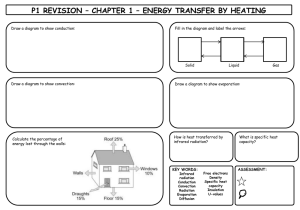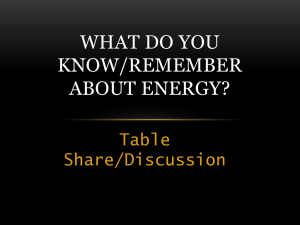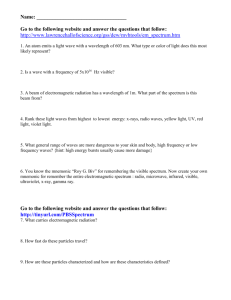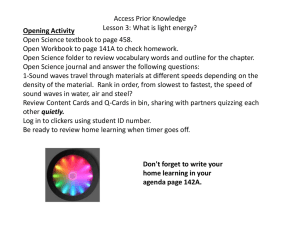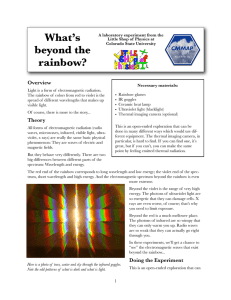P1_Revision_Sheets - Chew Valley School | Intranet Homepage
advertisement
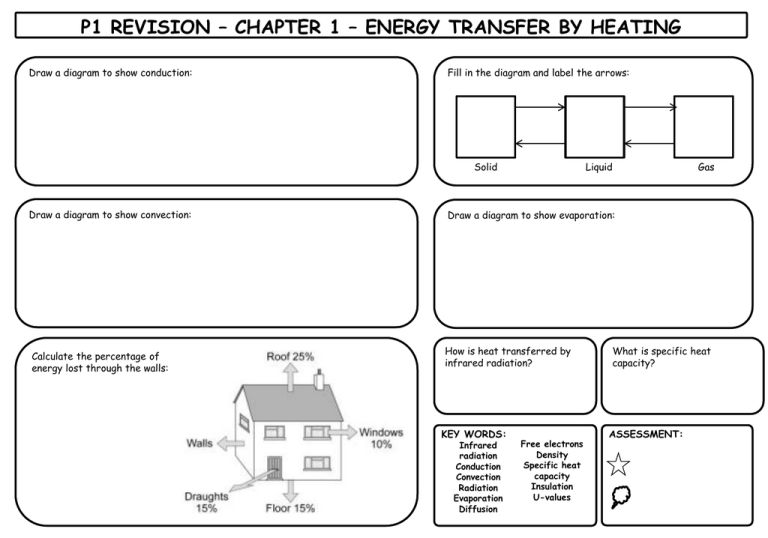
P1 REVISION – CHAPTER 1 – ENERGY TRANSFER BY HEATING Draw a diagram to show conduction: Fill in the diagram and label the arrows: Solid Draw a diagram to show convection: Calculate the percentage of energy lost through the walls: Liquid Gas Draw a diagram to show evaporation: How is heat transferred by infrared radiation? KEY WORDS: Infrared radiation Conduction Convection Radiation Evaporation Diffusion Free electrons Density Specific heat capacity Insulation U-values What is specific heat capacity? ASSESSMENT: P1 REVISION – CHAPTER 2 – USING ENERGY Write a definition for these different types of energy: What is conservation of energy? Calculate the amount of energy wasted as heat: Magnetic: Kinetic Thermal: Light: What is useful energy? Gravitational potential Chemical: Calculate the efficiency of the television: Sound: Electrical: What is wasted energy? Elastic potential Nuclear: Here is a sentence to help you remember them: Most Kids Hate Learning GCSE Energy Names KEY WORDS: Chemical energy Kinetic energy Gravitational potential energy Elastic potential energy Electrical energy Conservation of energy Useful energy Wasted energy Newtons (N) Joules (J) Sankey diagram Efficiency ASSESSMENT: P1 REVISION – CHAPTER 3 – ELECTRICAL ENERGY What is the cost of this electricity bill? Fill in the gaps: Appliances Useful Energy Wasted energy Light bulb Electric heather Electric toaster Electrical kettle If you needed to use a heater for 5 hours, which of these would be the most cost effective? Hair dryer Electric motor DVD drive KEY WORDS: Watt (W) Kilowatt (kW) Kilowatt-hour (kWh) Electricity meter Cost effective ASSESSMENT: P1 REVISION – CHAPTER 4 – GENERATING ELECTRICITY Why do we need to step- up and step-down the voltage? Explain supply and demand in terms of generating electricity: Fill in this table: Name of Energy Source 2 Advantages 2 Disadvantages Fossil fuel Label the parts of the power station: Renewable energy source KEY WORDS: Tidal power Carbon capture Biofuel and storage Atomic nucleus Solar cells Nuclear fission Solar heating National grid panels Step-up Renewable Geothermal transformers energy energy Step-down Wind power Acid rain transformers Hydroelectric power ASSESSMENT: P1 REVISION – CHAPTER 5 – WAVES Complete the ray diagrams to show reflection and refraction Name the parts of the wave: L= O M= N= O= P= P Don’t forget to label your diagrams properly with the angles (incidence, reflection & refraction) and normal lines Describe the sounds: A: C: B: D: What are mechanical waves? What are electromagnetic waves? What causes a sound wave? KEY WORDS: Complete the equation: Wave speed = frequency X _______ _________ = v = Hz X X m Mechanical Electromagnetic Perpendicular Transverse Longitudinal Amplitude Wavelength Frequency Plane mirror Normal Angle of incidence Angle of reflection Refraction Diffraction ASSESSMENT: P1 REVISION – CHAPTER 6 – ELECTROMAGNETIC WAVES Fill in the gaps in the electromagnetic spectrum: Radio Microwave What is the wavelength of light? Infrared Visible light What is the Doppler effect? Ultra violet X-Ray Gamma How do communicate using waves: Why are mobiles phones considered dangerous? What do we use visible light for? What do we use microwaves for? How do optical fibres work? (Draw a diagram) What is the Big Bang Theory? What do we use infrared for? What do we use radio waves for? KEY WORDS: Radio Microwave Infrared Visible light Ultraviolet X-ray Gamma White light Optical fibres Doppler effect Big bang theory Cosmic microwave background radiation ASSESSMENT:
